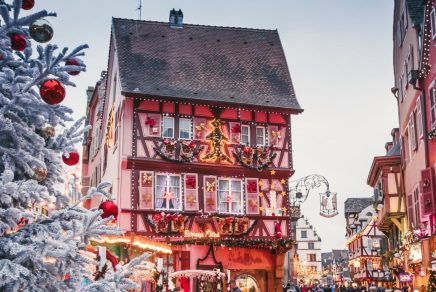The Bordeaux region, globally celebrated for its great wines, is also a haven of gastronomic delights. Beyond the prestigious châteaux and endless vineyards, it’s a land where the table tells a story—one of a rich and flavorful culinary tradition, rooted in generous local produce. If you’re wondering what to eat in Bordeaux, know that it’s an experience that awakens the senses, a journey into authentic flavors that combine the elegance of grand crus with the conviviality of regional dishes. Get your taste buds ready!
Bordeaux-Style Entrecôte
You can’t discuss Bordeaux cuisine without starting with its emblematic dish: the Bordeaux-style entrecôte. It is a true culinary institution here. Chefs perfectly sear the entrecôte, typically from Bazas beef, over hot embers. This local breed is renowned for its incredible tenderness and rich, marbled flavor.
What truly sets this dish apart is its signature sauce. Chefs craft it from finely chopped shallots, which they deglaze with Bordeaux red wine (often a Saint-Émilion or Médoc). They then generously enrich the sauce with butter and frequently garnish it with rich bone marrow. The wine’s aromatic depth perfectly marries the meat’s robust flavor, creating a beautifully balanced sensation on your palate. We traditionally serve it with crisp homemade fries or pan-fried cèpes (porcini mushrooms). Bordeaux-style entrecôte truly celebrates the simplicity and quality of local products.
Canelé
This small cake, instantly recognizable by its fluted shape and caramelized crust, is a true emblem of Bordeaux. Its history dates back to the nuns of the Annonciades convent. Legend says they used excess egg yolks from the châteaux, where wineries used the whites to clarify wine. In fact, the canelé features a dark, crisp crust, the result of prolonged baking in tinned copper molds. Its interior is soft and exquisitely flavored with vanilla and rum. This delightful contrast of textures and flavors provides all its charm. Enjoy it any time of day for a sweet treat; it pairs wonderfully with coffee or a glass of sweet wine.
Lamprey à la Bordelaise
For those who appreciate ancient traditions, Lamprey à la Bordelaise offers a unique culinary experience. The fish for this dish is caught nearby in the Gironde Estuary. The recipe is incredibly complex and rich: cooks simmer the lamprey for long hours in a thick, dark sauce made with Bordeaux red wine, leeks, onions, garlic, charcuterie (bacon, ham), and most importantly… its own blood. This last ingredient gives the sauce its deep color and its unique, earthy, powerful taste. Served with garlic croutons, this winter dish truly immerses you in the region’s gastronomic history.
Arcachon Oysters
Just a few kilometers from Bordeaux, the Arcachon Bay cultivates one of the region’s greatest marine treasures: oysters. People value them for their freshness, generous flesh, and inimitable briny taste, which reflects the richness of their oyster beds. People typically enjoy them plain, with a simple squeeze of lemon, a dash of shallot vinaigrette, or accompanied by a slice of buttered rye bread and a small glass of local dry white wine (like an Entre-Deux-Mers). It’s an unmissable experience for seafood lovers, often savored directly from
Lillet
Lillet is Bordeaux’s emblematic aperitif. Created in 1872 by the Lillet brothers in Podensac, it’s a wine-based aperitif characterized by the addition of fruit liqueurs (sweet and bitter oranges, quinine bark) and aged in oak barrels. It comes in white (the most famous), red, and more recently, rosé versions. Lillet Blanc, with its notes of candied citrus, honey, and tropical fruits, is particularly enjoyed chilled, over ice, often with a slice of orange or cucumber. It was even popularized by James Bond in the film Casino Royale.
Gratton de Lormont
Tourists know it less, but locals highly prize Gratton de Lormont, a simple and delicious cured meat specialty. Originating from the commune of Lormont, on the Garonne’s right bank, locals create this pork pâté from pieces of pork belly and neck they confit in their own fat. They then coarsely chop and press the mixture. Rich and flavorful, they often season it with parsley and garlic. People enjoy gratton cold, as a starter, sliced thickly on country bread, or as part of a picnic. It embodies the authentic taste of the terroir and yesteryear’s anti-waste cooking.
Dunes Blanches
More recent but already a cult favorite, pastry chef Pascal Lucas, from Cap Ferret on the Arcachon Bay, created the Dune Blanche. These little wonders are chouquettes (small cream puffs) that he fills with a light and airy whipped cream, often flavored with vanilla. He then generously dusts them with powdered sugar. Their name evokes the Atlantic coast’s sand dunes. Crispy on the outside and incredibly melt-in-your-mouth on the inside, they offer an explosion of sweetness and lightness—a true guilty pleasure you absolutely must discover.
Duck Magret
A classic from Southwest France! We prize this noble cut from a fattened duck’s breast for its red meat and marbled fat. Chefs generally grill or pan-fry it, scoring the skin for a crispy finish, and serve it rare to medium-rare. Simple accompaniments often join it: Sarladaise potatoes (cooked in duck fat with garlic and parsley), cèpes, or a simple green salad.
Crépinette
Finally, the Crépinette is another charcuterie specialty typical of Bordeaux, often associated with a surprising but delicious pairing: with oysters. It’s a small patty of ground meat, usually pork, but sometimes also veal, poultry, or a mixture, seasoned with parsley, garlic, and occasionally truffle or a few drops of Armagnac. It’s wrapped in a pork caul fat (a thin fatty membrane) before being pan-fried. Crépinette is traditionally served warm with fresh oysters, the melting fat of the charcuterie contrasting with and complementing the briny freshness of the seafood. It’s a bold combination that surprises and delights the palate.
Photo credit: Vincent Bengold




![Marseille_COUVERTURE[1] Marseille COUVERTURE](/wp-content/uploads/elementor/thumbs/Marseille_COUVERTURE1-rehd969x0bx0iqrlg0e2y32782i88bao83rijrgn6w.jpg)
![voyage_de_ski_dans_les_alpes_-_ski_trip_in_the_french_alps_-_COUVERTURE[1] Voyage de ski dans les Alpes - Ski trip in the French Alps - Couverture](/wp-content/uploads/elementor/thumbs/voyage_de_ski_dans_les_alpes_-_ski_trip_in_the_french_alps_-_COUVERTURE1-e1763071913669-renyn82g4stc735hil5xc0ospu44nnis74gdvy5d9k.jpg)


